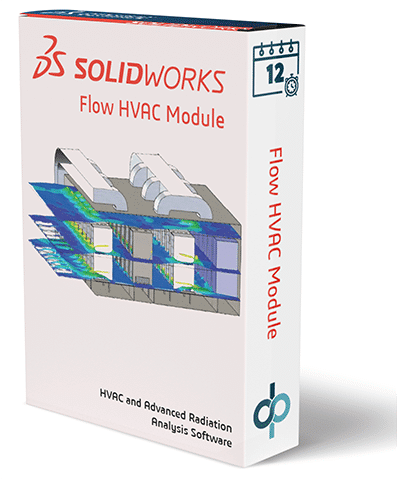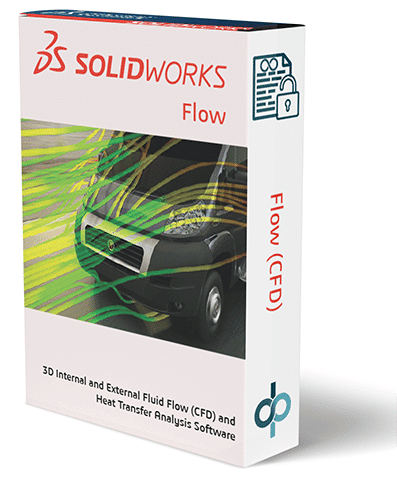SOLIDWORKS Simulation Professional
$585.00 – $625.00
Valid on perpetual licenses only. Excludes SOLIDWORKS Standard. Other exclusions may apply. Offer ends Dec. 26, 2025.

| Flow Simulation Feature Comparison | Flow | HVAC | Electronics | |
|---|---|---|---|---|
Ease of Use | ||||
SOLIDWORKS Simulation is fully embedded in SOLIDWORKS 3D CAD for ease of use and data integrity. Using the same user interface (UI) paradigms as SOLIDWORKS with toolbars, menus, and context-sensitive right-click menus ensures rapid familiarization. Built-in tutorials and searchable online help aid learning and troubleshooting. | ||||
Design Data Reuse | ||||
SOLIDWORKS Simulation supports SOLIDWORKS materials and configurations to analyze multiple loads and product configurations easily. | ||||
Multi-Parameter Optimization | ||||
Conduct an optimization study for more than one input variable using the Design of Experiments and Optimization parametric study. Run a calculation of design points and find optimum solutions. | ||||
SOLIDWORKS Flow Simulation Capabilities | ||||
| ||||
Material Database | ||||
SOLIDWORKS Flow Simulation: A customizable engineering database enables users to model and include specific solid, fluid, and fan behaviors. SOLIDWORKS Flow Simulation and HVAC Module: The HVAC engineering database extension adds specific HVAC components. SOLIDWORKS Flow Simulation and Electric Cooling Module: The Electronic Cooling extended engineering database includes specific electronic components and their thermal characteristics. | ||||
Internal Flow | ||||
Calculate the impact of fluid flow through your product. | ||||
External Flow | ||||
Calculate the impact of fluid flow around your product | ||||
2D – 3D | ||||
All calculations are on a full 3D domain by default. Where applicable, simulations can also be carried out in a 2D plane to reduce run time without affecting accuracy. | ||||
Heat Conduction in Solids | ||||
Calculating temperature change in the product's solid geometry is an option selection. Conjugate heat transfer through convection, conduction, and radiation can be created. Calculations can include thermal contact resistance. SOLIDWORKS Flow Simulation: Calculate pure heat conduction in solids to identify problems where no fluid exists for fast solutions. SOLIDWORKS Flow Simulation and HVAC Module: Include materials that are semitransparent to radiation for accurate solutions where the product's thermal load is influenced by transparent materials. SOLIDWORKS Flow Simulation and Electrical Cooling Module: Simulate specific electronics device effects
| ||||
Gravity | ||||
Include fluid buoyancy important for natural convection, free surface, and mixing problems. | ||||
Rotation | ||||
Ability to simulate moving/rotating surfaces or parts to calculate the effect of rotating/moving devices. | ||||
Free Surface | ||||
Lets you simulate flows with a freely moving interface between two immiscible fluids, such as gas-liquid, liquid-liquid, or gas-non-Newtonian liquid. | ||||
Symmetric | ||||
| ||||
Gases | ||||
Calculation of both ideal and actual flows for subsonic, transonic, and supersonic conditions. | ||||
Liquids | ||||
| ||||
Steam | ||||
Water vapor condensation and relative humidity are calculated for flows that include steam. | ||||
Boundary Layer Description | ||||
Laminar, turbulent, and transitional boundary layers are calculated using a modified Law of the Wall approach. | ||||
Mixing Flows | ||||
Immiscible Mixtures: perform flow of any pair of fluids belonging to gases, liquids, or non-Newtonian liquids. | ||||
Non Newtonian Fluids | ||||
Determine the flow behavior of Non-Newtonian liquids, such as oil, blood, sauce, etc. | ||||
Flow Conditions | ||||
Problems can be defined by velocity, pressure, mass, or volume flow conditions. | ||||
Thermal Conditions | ||||
Thermal characteristics for fluids and solids can be set locally and globally for accurate setup. | ||||
Wall Conditions | ||||
Local and global wall thermal and roughness conditions can be set for accurate setup. | ||||
Porous Components | ||||
Ability to treat some model components as porous media with the fluid flow through them or simulate them as fluid cavities with a distributed resistance to fluid flow. | ||||
Visualization | ||||
Visualize the stress and displacement of your assembly with customizable 3D plots. Animate the response of your assembly under loads to visualize deformations, vibration modes, contact behavior, optimization alternatives, and flow trajectories. | ||||
Results Customization | ||||
Provides the standard results components for structural analysis, such as von Mises stresses, displacements, temperature, etc. The intuitive equation-driven result plot enables you to customize the post-processing of structural analysis results to better understand and interpret product behavior. | ||||
Communication & Reporting | ||||
Create and publish customized reports for communicating simulation results and collaborating with eDrawings®. | ||||
Two-phase (Fluid + Particles) Flows | ||||
Ability to calculate (with the post-processor) in the obtained fields of results, motions of the specified particles (Particle Studies), or flows of the specified extraneous fluids (Tracer Study) in the fluid flow, which does not affect this fluid flow. | ||||
Noise Prediction (Steady State and Transient) | ||||
Noise prediction using a fast Fourier Transformation (FFT) algorithm that converts a time signal to the complex frequency domain for transient analysis. | ||||
HVAC Conditions | ||||
Include materials semi-permeable to radiation for accurate thermal analysis. | ||||
Tracer Study | ||||
HVAC applications vary widely. Considerations for meeting thermal performance and quality requirements include airflow optimization, temperature, air quality, and containment control. | ||||
Comfort Parameters | ||||
Understand and evaluate thermal comfort levels for multiple environments using thermal comfort factor analysis. | ||||
Electronic Conditions | ||||
| ||||

